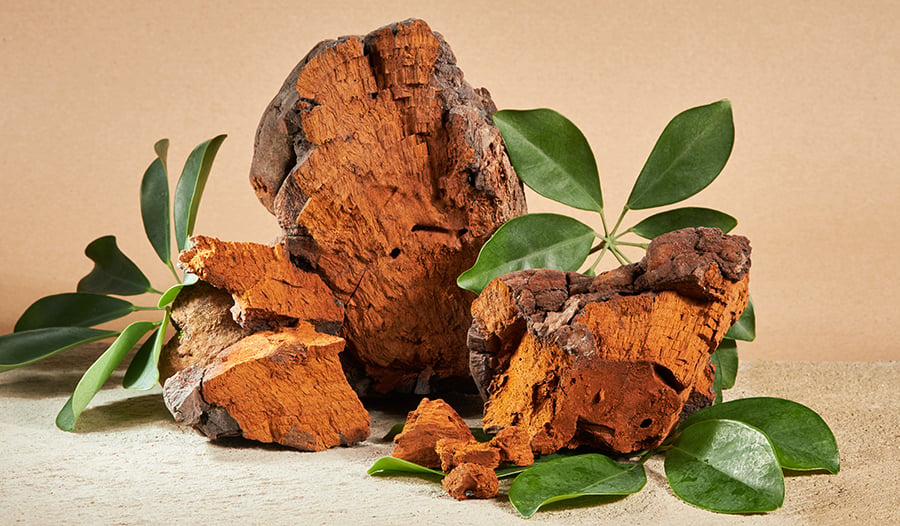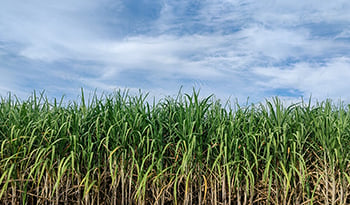Chaga Mushrooms: Uses, Benefits, and Risks
DISCLAIMER:This blog does not intend to provide diagnosis...
- In this article:
- What Is Chaga?
- Traditional Uses of Chaga Mushrooms
- Chaga Mushroom Nutrients
- Chaga Mushroom Health Benefits
- 1. Immune System Modulation
- 2. Reduce Inflammation
- 3. Adaptogenic Properties
- 4. Antibacterial and Antiviral Effects
- 5. May Support Healthy Blood Sugar and Metabolism
- 6. Synergistic Effects
- Chaga Mushroom Side Effects
- Are Chaga Mushrooms Sustainable?
- Takeaway

What Is Chaga?
Chaga (Inonotus obliquus) is a medicinal fungus native to Russia, Siberia, Europe, Canada, and northern parts of the United States and East Asia. This fungus grows predominately on birch trees (Betula spp.) but may grow on various other deciduous tree species, including beech, oak, alder, and ash. Chaga appears as a conk, a dark brown or black woody growth resembling a crusty, burnt mass on the trunks of these trees.
Beneath its dark woody exterior, chaga has bright rust-colored flesh full of antioxidant compounds. Although chaga is not technically a mushroom, it is often called a “medicinal mushroom” because it is also a fungus like mushrooms.
Traditional Uses of Chaga Mushrooms
Chaga has a rich history of use in Siberian, Russian, Scandinavian, and Native American folk medicine. In these traditional medicine systems, chaga was believed to possess a wide range of medicinal properties. Among the indigenous peoples of Siberia, it is traditionally used to promote longevity, alleviate digestive disorders, relieve colds and respiratory infections, and has been used topically for skin conditions.
Chaga conks are typically grated into a fine powder and traditionally prepared as a tea or decoction. Today, this powder can be taken as a tea, tincture, powder, or capsule. Chaga is available on its own and as a component of medicinal mushroom blends. Mushroom blends are often sold as powders and mixed into other liquids for daily use.
Chaga's popularity has surged in recent years due to its reputation as an adaptogen and its potential role in promoting overall health and improving various medical conditions. Today, modern scientific research is drawing on traditional knowledge and investigating the many health benefits of chaga.
Chaga Mushroom Nutrients
Chaga contains a wide variety of bioactive compounds responsible for its health effects. Below are some of the key constituents found in chaga:
Polysaccharides
Chaga is rich in beta-glucans, a polysaccharide known for its immune-boosting properties. These compounds may enhance the activity of immune cells, such as macrophages and T-cells, helping the body defend against infections and diseases. Beta-glucans are also found in other medicinal mushrooms like reishi and maitake, oats, seaweed, and algae.
Antioxidants
Chaga is an excellent source of antioxidants, including phenolic compounds and flavonoids. These antioxidants help combat oxidative stress and reduce cellular damage caused by free radicals, and may increase superoxide dismutase and glutathione in the body.
Betulinic Acid
When growing on birch trees, chaga can accumulate betulinic acid from the tree. Betulinic acid has shown promising anti-inflammatory and antitumor properties in preclinical studies.
Melanin
Chaga’s dark color is due to its high melanin content. Melanin may act as an antioxidant and offer protective effects against oxidative stress. In the human body, melanin is responsible for skin pigmentation and helps block UV radiation, which can damage DNA in our skin cells, leading to skin cancer and aging. Nutrients like tyrosine and copper are important for melanin production.
Chaga Mushroom Health Benefits
1. Immune System Modulation
Chaga's immune-boosting properties are attributed to its polysaccharides, including beta-glucans. These compounds stimulate the production and activity of immune cells, enhancing the body's ability to fend off infections.
Specifically, beta-glucans have been shown to activate the cells of our innate immune system. These cell types are the first-line response to pathogens and start fighting off infections before our immune system has started making specific antibodies to invading microbes. Additionally, chaga may improve the production of cytokines, or chemical messengers that help our immune cells communicate with one another.
2. Reduce Inflammation
Inflammation is implicated in the development of many chronic diseases. Betulinic acid, abundant in chaga, has exhibited anti-inflammatory effects in preclinical studies. These findings suggest chaga may have potential applications in managing inflammatory conditions because of its high betulinic acid content. Additionally, chaga contains other antioxidant and anti-inflammatory compounds, which may all help reduce oxidative damage from inflammation in the body.
3. Adaptogenic Properties
Chaga has been used in traditional medicine to promote vitality and overall health. This fungus is a potent adaptogen, a substance believed to help the body adapt to stressors and maintain homeostasis.
While chaga may not be as well-known as popular adaptogens like ashwagandha or rhodiola, historical and traditional use confirm that chaga has long been used to help our bodies respond to the demands of our environment. Recent animal studies suggest chaga may improve physiologic response to stressful situations.
4. Antibacterial and Antiviral Effects
Beyond its immune system effects, chaga has been investigated for its antiviral and antibacterial properties. Some studies indicate that chaga extracts may inhibit the growth of certain viruses and bacteria.
One recent computer model-based study suggests constituents of chaga, including beta-glucans, betulinic acid, and other polysaccharides, may block the binding of SARS-CoV-2 with human cells. Although further research is needed, these findings suggest chaga may have potent antimicrobial properties against various pathogens.
Chaga may be a powerful ally for supporting the body’s response to invading pathogens due to both its antimicrobial and immune-stimulating actions.
5. May Support Healthy Blood Sugar and Metabolism
Chaga’s polysaccharide compounds have been shown to improve blood sugar regulation and cholesterol in animal studies. In one study, mice fed chaga polysaccharides had improved fasting blood sugar and reduced insulin resistance. Other animal model studies have shown chaga polysaccharides may reduce total cholesterol, LDL “bad” cholesterol, and triglycerides while raising heart-protective HDL cholesterol.
Since these studies have only been conducted on animals, there is no way of knowing if these effects translate to humans, but the results are promising and warrant more research on the effects of chaga on metabolism, blood sugar, and cholesterol.
6. Synergistic Effects
Chaga is often blended with other medicinal and adaptogenic mushrooms, like reishi, shiitake, cordyceps, and lion’s mane. Each type of medicinal mushroom or fungus has different properties and constituents. By blending them, we can experience effects from multiple species that may complement each other.
For instance, chaga may be energizing for some people, while reishi has a more calming nature. Using these two fungi simultaneously may improve the effects of both. Additionally, many medicinal mushrooms contain potent immune-modulating compounds, so using multiple types of mushrooms can help round out an immune support protocol.
Chaga Mushroom Side Effects
Chaga is generally considered safe for most individuals when consumed in moderation. However, there are some important considerations and potential risks for certain individuals.
Due to its potential blood-thinning effects, chaga may interact with certain medications, particularly anticoagulants and antiplatelet drugs. Individuals taking blood-thinning medications should talk to a healthcare provider before using chaga. Since chaga may lower blood sugar, individuals taking medications or supplements for diabetes should talk to a healthcare provider before using chaga.
Chaga contains oxalic acid, which can cause kidney problems or promote the development of kidney stones in high amounts. Individuals with a history of kidney stones or kidney disease should be cautious when using chaga.
Although rare, some individuals may be allergic to chaga, leading to allergic reactions when consumed. It is a good practice to start with a small dose to assess tolerance, especially if you are consuming chaga for the first time.
Chaga can accumulate heavy metals from their environment. The quality and purity of chaga can vary significantly between brands and sources. It is essential to source chaga supplements or extracts from reputable suppliers to ensure safety and efficacy.
Are Chaga Mushrooms Sustainable?
Overharvesting of chaga has become a concerning issue due to its growing popularity. Chaga is relatively easy to identify, so it is prone to overharvesting. This poses a significant threat to both chaga populations and the ecosystems they inhabit.
Sustainable harvesting practices are crucial to ensure the long-term availability of chaga and to protect the delicate balance of forest ecosystems. By emphasizing responsible collection methods, limiting the harvest to a sustainable level, and respecting the natural growth cycle of Chaga, we can preserve this valuable medicine for future generations.
Takeaway
Chaga has been used for centuries in traditional medicine. This medicinal fungus and its constituents have a wide variety of effects on the body, including supporting the immune system, reducing inflammation, and increasing antioxidants. Chaga has exhibited many health benefits including antibacterial, antiviral properties in preclinical studies. While the scientific evidence supporting these claims is encouraging, further research, including clinical trials in humans, is needed to establish its effects definitively.
References:
- Lee M.W., Hur H., Chang K.C., Lee T.S., Ka K.H., Jankovsky L. Introduction to Distribution and Ecology of Sterile Conks of Inonotus obliquus. Mycobiology. 2008;36:199–202.
- Lu Y, Jia Y, Xue Z, Li N, Liu J, Chen H. Recent Developments in Inonotus obliquus (Chaga mushroom) Polysaccharides: Isolation, Structural Characteristics, Biological Activities and Application. Polymers (Basel). 2021 Apr 29;13(9):1441.
- Niu H., Song D., Mu H.B., Zhang W.X., Sun F.F., Duan J.Y. Investigation of three lignin complexes with antioxidant and immunological capacities from Inonotus obliquus. Int. J. Biol. Macromol. 2016;86:587–593.
- Géry A, Dubreule C, André V, Rioult JP, Bouchart V, Heutte N, Eldin de Pécoulas P, Krivomaz T, Garon D. Chaga ( Inonotus obliquus), a Future Potential Medicinal Fungus in Oncology? A Chemical Study and a Comparison of the Cytotoxicity Against Human Lung Adenocarcinoma Cells (A549) and Human Bronchial Epithelial Cells (BEAS-2B). Integr Cancer Ther. 2018 Sep;17(3):832-843.
- Fulda S. Betulinic Acid for cancer treatment and prevention. Int J Mol Sci. 2008 Jun;9(6):1096-1107.
- Xu L., Yu Y.F., Sang R., Ge B.J., Wang M., Zhou H.Y., Zhang X.M. Inonotus obliquus polysaccharide protects against adverse pregnancy caused by Toxoplasma gondii infection through regulating Th17/Treg balance via TLR4/NF-kappa B pathway. Int. J. Biol. Macromol. 2020;146:832–840.
- Kang J. H., Jang J. E., Mishra S. K., Lee H. J., Nho C. W., Shin D., et al. (2015). Ergosterol Peroxide from Chaga Mushroom (Inonotus Obliquus) Exhibits Anti-cancer Activity by Down-Regulation of the β-catenin Pathway in Colorectal Cancer. J. Ethnopharmacol. 173, 303–312.
- Arata S, Watanabe J, Maeda M, Yamamoto M, Matsuhashi H, Mochizuki M, Kagami N, Honda K, Inagaki M. Continuous intake of the Chaga mushroom (Inonotus obliquus) aqueous extract suppresses cancer progression and maintains body temperature in mice. Heliyon. 2016 May 12;2(5):e00111.
- Lemieszek MK, Langner E, Kaczor J, Kandefer-Szerszeń M, Sanecka B, Mazurkiewicz W, Rzeski W. Anticancer effects of fraction isolated from fruiting bodies of Chaga medicinal mushroom, Inonotus obliquus (Pers.:Fr.) Pilát (Aphyllophoromycetideae): in vitro studies. Int J Med Mushrooms. 2011;13(2):131-43.
- Glamočlija J, Ćirić A, Nikolić M, Fernandes Â, Barros L, Calhelha RC, Ferreira IC, Soković M, van Griensven LJ. Chemical characterization and biological activity of Chaga (Inonotus obliquus), a medicinal "mushroom". J Ethnopharmacol. 2015 Mar 13;162:323-32.
- Eid JI, Al-Tuwaijri MM, Mohanty S, Das B. Chaga mushroom (Inonotus obliquus) polysaccharides exhibit genoprotective effects in UVB-exposed embryonic zebrafish (Danio rerio) through coordinated expression of DNA repair genes. Heliyon. 2021 Feb 4;7(2):e06003.
- Wang J, Wang C, Li S, Li W, Yuan G, Pan Y, Chen H. Anti-diabetic effects of Inonotus obliquus polysaccharides in streptozotocin-induced type 2 diabetic mice and potential mechanism via PI3K-Akt signal pathway. Biomed Pharmacother. 2017 Nov;95:1669-1677.
- Yang M, Hu D, Cui Z, Li H, Man C, Jiang Y. Lipid-Lowering Effects of Inonotus obliquus Polysaccharide In Vivo and In Vitro. Foods. 2021; 10(12):3085.
- Hyun KW, Jeong SC, Lee DH, Park JS, Lee JS. Isolation and characterization of a novel platelet aggregation inhibitory peptide from the medicinal mushroom, Inonotus obliquus. Peptides. Jun 2006;27(6):1173-1178.
- Kwon O, Kim Y, Paek JH, Park WY, Han S, Sin H, Jin K. Chaga mushroom-induced oxalate nephropathy that clinically manifested as nephrotic syndrome: A case report. Medicine (Baltimore). 2022 Mar 11;101(10):e28997.

 By Dr. Josh Corn, N.D.
By Dr. Josh Corn, N.D.


